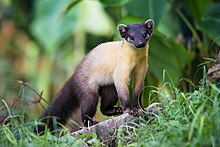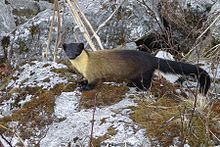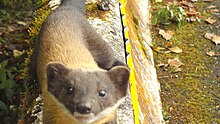Yellow-throated marten
| Yellow-throated marten Temporal range: Pliocene – Recent
| |
|---|---|

| |
| Martes flavigula indochinensis in Kaeng Krachan National Park | |
| Scientific classification | |
| Domain: | Eukaryota |
| Kingdom: | Animalia |
| Phylum: | Chordata |
| Class: | Mammalia |
| Order: | Carnivora |
| Family: | Mustelidae |
| Genus: | Martes |
| Species: | M. flavigula
|
| Binomial name | |
| Martes flavigula Boddaert, 1785
| |
| Subspecies | |
|
M. f. flavigula (Boddaert, 1785) | |

| |
| Yellow-throated marten range | |
| Synonyms | |
|
Charronia flavigula (Boddaert) | |
The yellow-throated marten (Martes flavigula) is a marten species native to the Himalayas, Southeast and East Asia. Its coat is bright yellow-golden, and its head and back are distinctly darker, blending together black, white, golden-yellow and brown. It is the second-largest marten in the Old World, after the Nilgiri marten,[2] with its tail making up more than half its body length.
It is an
Characteristics
The yellow-throated marten has short bright brownish-yellow fur, a blackish brown pointed head, reddish cheeks, light brown chin and lower lips; the chest and lower part of the throat are orange-golden, and flanks and belly are bright yellowish. The back of the ears is black, the inner portions are yellowish gray. The front paws, lower forelimbs are black. The tail is black above with a grayish brown base and a lighter tip.[3] It is robust and muscular, has an elongated thorax, a long neck and a long tail, which is about 2/3 as long as its body. The limbs are relatively short and strong, with broad paws.[4] The ears are large and broad with rounded tips. The soles of the feet are covered with coarse, flexible hairs, though the digital and foot pads are naked and the paws are weakly furred.[3] The baculum is S-shaped, with four blunt processes occurring on the tip. It is larger than other Old World martens; males measure 500–719 mm (19.7–28.3 in) in body length, while females measure 500–620 mm (20–24 in). Males weigh 2.5–5.7 kg (5.5–12.6 lb), while females weigh 1.6–3.8 kg (3.5–8.4 lb).[5] The anal glands sport two unusual protuberances, which secrete a strong smelling liquid for defensive purposes.[6]
Distribution and habitat



The yellow-throated marten occurs in Afghanistan and Pakistan, in the
In
In northeastern India, it has been reported in northern West Bengal, Arunachal Pradesh, Manipur and Assam. In Indonesia it occurs in Borneo, Sumatra, and Java.[9]
Behaviour and ecology
The yellow-throated marten holds extensive, but not permanent, home ranges. It actively patrols its territory, having been known to cover 10–20 km (6.2–12.4 mi) in a single day and night. It primarily hunts on the ground, but can climb trees proficiently, being capable of making jumps up to 8–9 m (26–30 ft) between branches. After March snowfalls, the yellow-throated marten restricts its activities to treetops.[10]
Diet
The yellow-throated marten is a
It supplements its diet with nectar and fruit, and is therefore considered to be an important seed disperser.[15]
Reproduction
Predators
The yellow-throated marten has few predators, but occasionally may fall foul of larger carnivores; remains of sporadic individuals have turned up in the scat or stomachs of Siberian tigers (Panthera tigris) and Asian black bears (Ursus thibetanus).[16][17] A mountain hawk-eagle (Nisaetus nipalensis) killed an adult yellow-throated marten.[18]
Conservation
The yellow-throated marten is listed as
Taxonomy
The first written description of the yellow-throated marten in the
As of 2005[update], nine subspecies are recognized.[20]
| Subspecies | Trinomial authority | Description | Range | Synonyms |
|---|---|---|---|---|
| Indian kharza (M. f. flavigula)
( Nominate subspecies )

|
Bodaert, 1785 | A large subspecies distinguished by the absence of a naked area of skin above the plantar pad of the hind foot, a larger mat of hair between the plantar and carpal pads of the forefoot and by its longer, more luxuriant winter coat[21] | chrysogaster (C. E. H. Smith, 1842) hardwickei (Horsfield, 1828) | |
| Amur yellow-throated marten (M. f. borealis) | Radde, 1862 | Distinguished from flavigula by its denser and longer winter fur and somewhat larger general dimensions.[22] | Korean Peninsula
|
koreana (Mori, 1922) |
| Formosan yellow-throated marten (M. f. chrysospila) | Swinhoe, 1866 | Taiwan | xanthospila (Swinhoe, 1870) | |
| Hainan yellow-throated marten (M. f. hainana) | Hsu and Wu, 1981 | Hainan island | ||
| Sumatran yellow-throated marten (M. f. henrici) | Schinz, 1845 | Sumatra | ||
| Indochinese yellow-throated marten (M. f. indochinensis) | Kloss, 1916 | Distinguished from flavigula by the presence of a naked area of skin above the plantar pad of the hind feet and the area between the plantar and carpal pads on the forefeet. The winter coat is shorter and less luxuriant, with the color being paler, rather yellower on the shoulders and upper back, the loins are less deeply pigmented and the nape is more profusely speckled with yellow. The belly is a dirty white in color and the throat pale yellow.[23] | Northern Tenasserim, Thailand and Vietnam | |
| Malaysian yellow-throated marten (M. f. peninsularis) | Bonhote, 1901 | Similar to indochinensis, but distinguished by its brown, rather than black, head, with the nape being the same color as the shoulders, being usually buff or yellowish brown. The shoulders and upper back are not as yellow as in indochinensis and the abdomen is always darkish brown, while the throat varies from orange-yellow to cream. The fur is short and thin[24] | Southern Tenasserim and the Malay Peninsula | |
| Javan yellow-throated marten (M. f. robinsoni) | Pocock, 1936 | western Java | ||
| Bornean yellow-throated marten (M. f. saba) | Chasen and Kloss, 1931 | Borneo |
References
- ^ . Retrieved 19 November 2021.
- ^ Prater, S. H. (1971). The Book of Indian Animals (3rd ed.). Mumbai: Bombay National History Society.
{{cite book}}: CS1 maint: location missing publisher (link) - ^ a b Heptner & Sludskii 2002, pp. 906–907
- ^ Heptner & Sludskii 2002, pp. 905–906
- ^ Heptner & Sludskii 2002, pp. 907–908
- ^ Pocock 1941, pp. 337
- .
- ^ Appel, A.; Khatiwada, A. P. (2014). "Yellow-throated Martens Martes flavigula in the Kanchenjunga Conservation Area, Nepal". Small Carnivore Conservation. 50: 14–19.
- ISBN 978-0-387-22580-7.
- ^ Heptner & Sludskii 2002, pp. 917–918
- ^ a b Pocock 1941, pp. 336
- ^ a b Heptner & Sludskii 2002, pp. 915–916
- ^ a b Heptner & Sludskii 2002, pp. 919
- ISBN 2-8317-0462-6.
- S2CID 55387571.
- PMID 25939758.
- from the original on 2023-04-21. Retrieved 2023-04-21.
- ^ Fam, S. D.; Nijman, V. (2011). "Spizaetus hawk-eagles as predators of arboreal colobines". Primates. 52 (2): 105–110.
- ^ Horsfield, T. (1851). A catalogue of the Mammalia in the Museum of the East-India Company. London: J. & H. Cox. Archived from the original on 2023-04-08. Retrieved 2017-08-30.
- OCLC 62265494.
- ^ Pocock 1941, pp. 331–337
- ^ Heptner & Sludskii 2002, pp. 914
- ^ Pocock 1941, pp. 338
- ^ Pocock 1941, pp. 339
Bibliography
- Allen, G. M. (1938). The mammals of China and Mongolia, Volume 1. New York : American Museum of Natural History.
- Heptner, V. G.; Sludskii, A. A. (2002) [1972]. "Subgenus of Himalayan Martens, or Kharza". Mlekopitajuščie Sovetskogo Soiuza. Moskva: Vysšaia Škola [Mammals of the Soviet Union,]. Vol. II, Part 1b, Carnivores (Mustelidae and Procyonidae). Washington, D.C.: Smithsonian Institution Libraries and National Science Foundation. pp. 905–920. ISBN 90-04-08876-8.
- Pocock, R. I. (1941). "Charronia flavigula (Boddaert). the Yellow-throated Marten". The Fauna of British India, including Ceylon and Burma. Vol. Mammals 2. London: Taylor and Francis. pp. 331–340.



